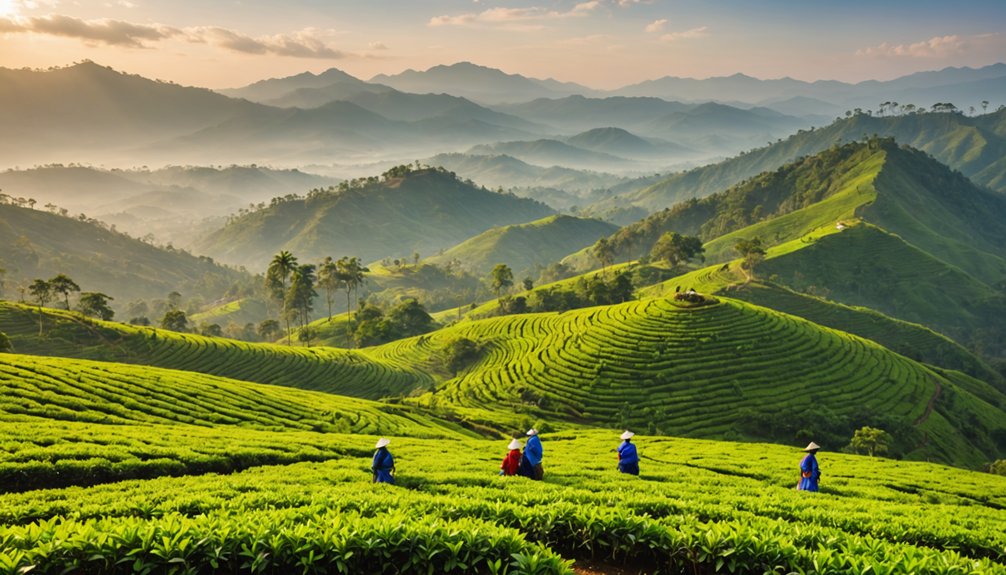The best time to visit Sri Lanka is between December and April, when you’ll enjoy pristine weather with temperatures of 25-32°C along the coast and 15-21°C in the Hill Country. You’ll find sunny skies and calm seas perfect for beach activities along the south and west coasts during this period. While accommodation prices rise 30-50% in peak season, you’ll experience ideal conditions for wildlife viewing, cultural festivals, and exploring major attractions. Each region offers unique seasonal advantages worth exploring further.
Key Takeaways
- December to April offers optimal weather with sunny skies, moderate temperatures, and minimal rainfall across most popular tourist destinations.
- May to September is perfect for exploring the east coast beaches and surfing at Arugam Bay during the Yala monsoon.
- October to November experiences island-wide showers, making it less ideal for beach activities but offering better accommodation rates.
- Cultural events and wildlife viewing peak between January and March, with numerous festivals and optimal conditions for safaris.
- Budget travelers should consider May-August for significant discounts, though southwest regions experience monsoon rains during this period.
Understanding Sri Lanka’s Monsoon Patterns
When planning a trip to Sri Lanka, you’ll need to understand its complex monsoon patterns, which effectively split the island into two distinct climate zones. The island experiences two primary monsoons: Yala (May-September) affects the southwest, while Maha (December-February) influences the northeast.
You’ll encounter significant monsoon variability trends throughout the year. During Yala, you should explore the northeast’s sunny beaches while avoiding the rain-soaked southwest. Conversely, Maha season’s perfect for discovering the Cultural Triangle and southwest coast. The inter-monsoon periods (March-April and October-November) bring island-wide showers, with October featuring particularly intense storms. Outside of these monsoon periods, the island enjoys warm sunny weather year-round.
Recent climate change adaptation measures have become indispensable as monsoon patterns grow more unpredictable. Since 2000, rainfall variability has increased by 15%, leading to more extreme weather events. You’ll find many coastal areas now equipped with flood-resistant infrastructure, and eco-resorts designed to withstand these changing conditions.
Peak Season Travel Guide: December to April
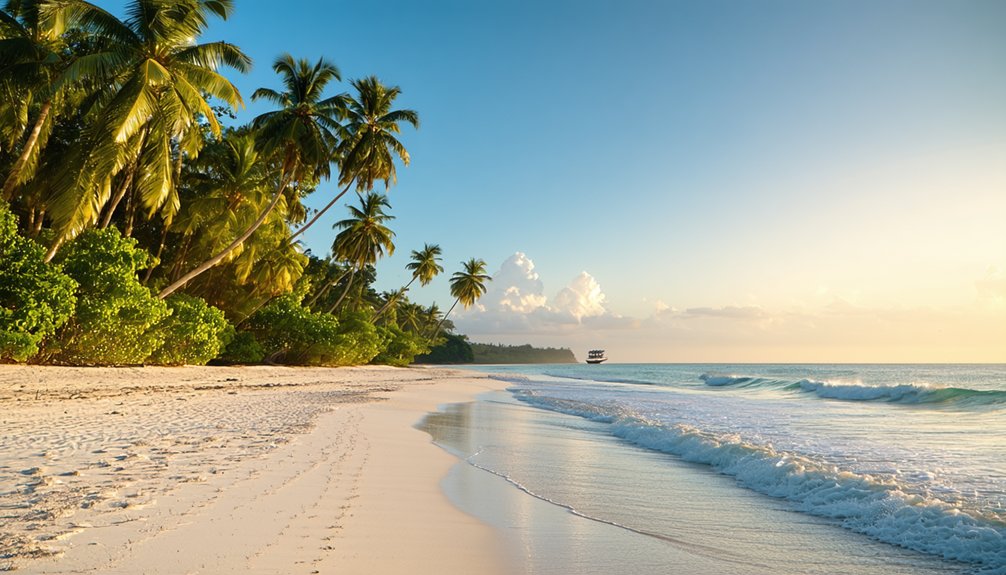
You’ll find Sri Lanka’s peak season from December to April offers pristine weather conditions, with temperatures ranging from 25-32°C along the coast and cooler 15-21°C in the Hill Country regions. During this time, popular attractions like Sigiriya Rock Fortress and Galle Fort experience significant crowds, while accommodation prices surge 30-50% above standard rates. The south-west and south coast regions are particularly favorable during this period, offering sunshine and calm seas. To make the most of your visit, you’ll need to secure your bookings well in advance, particularly for the Christmas and New Year period when availability becomes extremely limited.
Ideal Weather Conditions
Sri Lanka’s peak tourist season from December to April offers the most favorable weather conditions across much of the island nation. You’ll find pleasantly warm temperatures ranging from 27°C-32°C, with humidity levels staying manageable at 70-80%. The country’s unique position in the Indian Ocean contributes to its tropical climate year-round. Rainfall patterns during this period favor the south and west coasts, keeping them dry and perfect for beach activities, while the Cultural Triangle enjoys clear skies ideal for exploring ancient sites.
- South and west coastal areas experience ideal beach weather with sea temperatures of 28°C-30°C
- Cultural Triangle remains dry with temperatures reaching up to 34°C in April
- Hill Country maintains cooler temperatures around 19°C, perfect for trekking
- UV index stays consistently high, so sun protection is essential
- Brief afternoon showers in April are typically short-lived, not disrupting daily activities
Crowded Tourist Attractions
The perfect weather conditions during peak season attract massive crowds to Sri Lanka’s most celebrated destinations. You’ll encounter significant wait times at popular sites, with Sigiriya’s summit climb taking up to 2 hours and Dambulla Cave Temple requiring 30+ minute queues. Visitor management strategies now include timed entry at the Temple of the Tooth and staggered admission at UNESCO sites. Consider visiting during shoulder season rates to enjoy significant savings on accommodations and activities while avoiding the largest crowds.
| Location | Peak Season Crowds | Crowd Control Measures |
|---|---|---|
| Sigiriya | 6,000 daily visitors | Timed ascent groups |
| Yala Park | Heavy jeep traffic | Limited vehicle entry |
| Kandy Temple | High congestion | Scheduled tickets |
| Galle Fort | Street bottlenecks | Pedestrian zones |
| Beach Resorts | 80% occupancy | Guest-only access |
Planning ahead is vital – book accommodations 6 months in advance, especially for family-friendly resorts, and consider visiting popular attractions during early morning hours to avoid the largest crowds.
Peak Season Booking Tips
Planning a peak season trip to paradise requires careful strategy and advance preparation. You’ll need to secure your accommodations 3-6 months ahead, especially for popular coastal destinations like Galle and Mirissa. Check hotel rating reliability on verified booking platforms and understand accommodation deposit policies before committing. For the best value, target shoulder-season rates in October-November or April, when you’ll find similar weather conditions with fewer crowds. The island’s ideal travel duration for exploring major attractions is minimum two weeks, allowing you to properly experience both cultural sites and beaches without rushing.
- Book train journeys on scenic routes like Kandy-Ella at least 2-4 weeks in advance
- Compare all-inclusive packages that bundle accommodations and activities
- Consider splitting your stay between coastal and inland regions for better availability
- Negotiate directly with locally owned properties for long-stay discounts
- Purchase thorough travel insurance to protect against monsoon-related cancellations
Regional Weather Breakdown by Coast
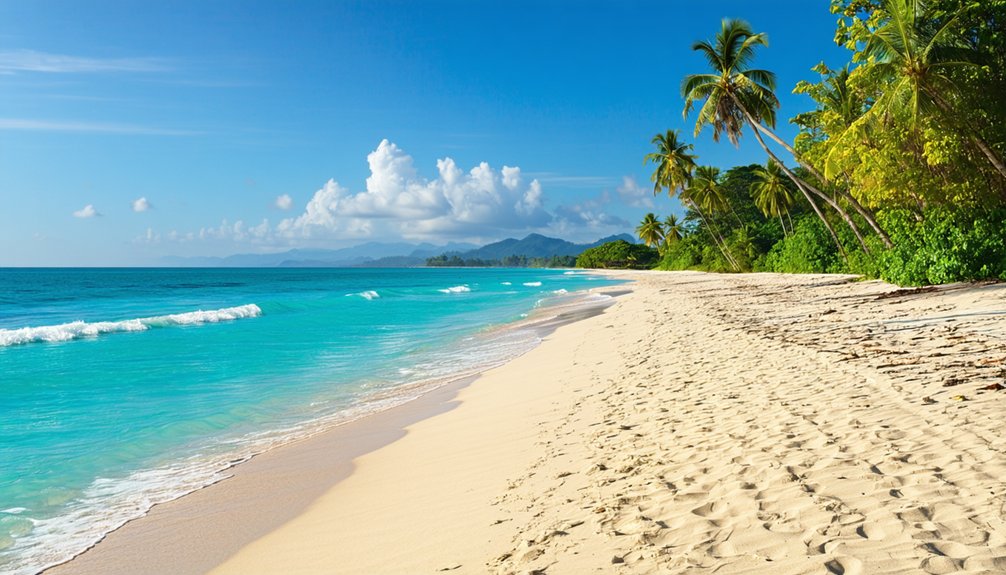
Sri Lanka’s coastal regions showcase distinct weather patterns, with the south coast experiencing heavy rainfall (300-350mm monthly) during the southwest monsoon from May to September, though August offers a brief respite. You’ll find the east coast’s weather cycle nearly opposite, featuring ideal conditions from April to September with pleasant 30-34°C temperatures and reduced humidity levels around 60%. The northwest zone follows similar patterns to the west coast but experiences less intense monsoon effects, making places like Negombo and Kalpitiya manageable even during shoulder seasons. The picturesque Pasikudah resort area along the east coast has become particularly popular for its sheltered bay and consistent weather conditions.
South Coast Monsoon Patterns
Several distinct monsoon patterns shape South Coast weather throughout the year, with the southwest monsoon (Yala) dominating from May to September. You’ll experience significant rainfall fluctuations and coastal erosion impact during this period, particularly in southwestern regions receiving 2,500-5,000mm annually. The eastern areas like Tangalle see 25% less precipitation than western zones like Galle. The pleasant climate of moderate temperatures 27°C makes the region comfortable for visitors year-round.
- December-April offers the driest conditions with 70-90mm monthly rainfall
- Eastern South Coast enjoys relatively settled weather May-September
- October-November brings island-wide thunderstorms and cyclonic activity
- Evening hours see peak rainfall due to solar heating effects
- La Niña conditions increase December-February precipitation
When planning your coastal adventure, you’ll find December-April most favorable, while October-November’s heavy rains make travel challenging. The eastern coast’s microclimate offers more stability, making it an excellent alternative during western monsoons.
East Coast Weather Cycles
While the South Coast experiences its distinct weather patterns, the East Coast follows its own unique rhythmic cycles throughout the year. You’ll find prime east coast tourism trends during the April-September dry season, when the southwest monsoon leaves this region pleasantly sunny and accessible. Cool sea breezes from shorelines help moderate the intense coastal temperatures.
| Season | Months | Rainfall | Tourism Impact |
|---|---|---|---|
| Northeast Monsoon | Oct-Jan | Heavy (300mm/month) | Limited Access |
| Inter-monsoon | Mar-Apr | Light Showers | Moderate |
| Dry Season | Apr-Sep | Minimal (<35mm) | Peak Season |
| Peak Monsoon | Oct-Dec | Intense | Avoid Travel |
East coast rainfall variability creates distinct travel windows. You’ll experience temperatures ranging from 32-34°C during peak months, with Trincomalee reaching up to 38°C. The northeast monsoon delivers about half the annual rainfall between October and January, making these months less suitable for coastal activities.
Northwest Climate Variations
Understanding the northwest’s climate patterns requires familiarity with its dual monsoon system, where you’ll encounter distinct variations across Negombo, Mannar, and the Puttalam/Kalpitiya regions. The varying rainfall patterns create a dynamic landscape, with Negombo experiencing peak rains during May-July, while Mannar sees its wettest period from October through December. The region’s coastal waters are ideal for whale watching tours during the winter months.
- Negombo’s southwest monsoon dominance means you’ll find drier conditions from December to March
- Mannar’s arid landscape transforms during the northeast monsoon, perfect for nature enthusiasts
- Puttalam/Kalpitiya offers dual peaks: November-December (255mm) and May (150mm)
- Seasonal temperature changes remain modest, ranging 27-30°C in coastal areas
- Northern regions maintain semi-arid conditions, with annual rainfall below 1,000mm
You’ll experience more stable temperatures along the coast, while inland areas like Puttalam offer slightly cooler conditions than seaside Negombo.
Cultural Triangle & Hill Country Climate Tips

Planning your visit around Sri Lanka’s distinct climate patterns in the Cultural Triangle and Hill Country can make or break your experience. In the Cultural Triangle, you’ll find optimal conditions from January to March, with warm days averaging 27-31°C and manageable humidity levels around 60%. Start your explorations at sunrise to avoid the intense midday heat, as temperatures can soar to 32°C by noon. Red Dot Tours offers specialized holiday packages to help you make the most of these ideal weather windows.
The Hill Country offers a refreshing escape with its cooler climate. February stands out as the ideal month, delivering 7 daily sunshine hours and moderate rainfall of 108mm. You’ll want to pack layers, as temperatures can dip to 15°C at night. Note that altitude significantly impacts conditions – Kandy at 500m runs about 8°C warmer than Nuwara Eliya at 1,900m. For the best of both regions, schedule your visit in March when you can comfortably explore both areas with minimal rainfall interference.
Wildlife Viewing & Safari Seasons
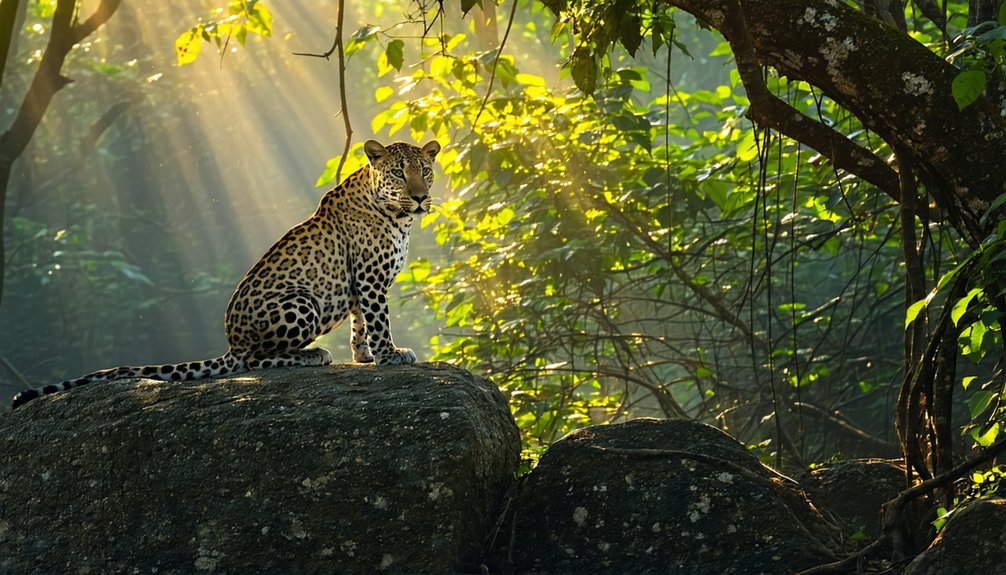
Sri Lanka’s wildlife viewing calendar operates on its own distinct rhythm, shaped by the interplay of monsoons and animal behavior patterns. You’ll find the southwest parks like Yala and Udawalawe at their best from December to March, while eastern sanctuaries peak between February and September. For ideal wildlife encounters, plan around key seasonal events like “The Gathering,” when over 300 elephants congregate at Minneriya’s waterholes from July to September. The dry weather conditions from January to March create optimal opportunities to observe more active wildlife.
- Endemic bird species are visible year-round in Sinharaja, with 26 unique species calling the rainforest home
- Nocturnal wildlife safaris in Bundala (December-February) reveal jungle cats and owls
- Leopard sightings peak in Yala during June-September, with a 35% success rate
- Blue whales frequent Mirissa’s waters from December to April
- Morning drives (6-10am) offer 40% more wildlife sightings than afternoon safaris
For maximum flexibility, consider shoulder seasons (April, September-October) when planning multi-park itineraries, as weather patterns remain balanced across regions.
Major Festivals & Cultural Events Calendar

Sri Lanka’s calendar bursts with vibrant religious and cultural celebrations, from major Buddhist Peraheras to Hindu temple festivals, making it essential to plan your visit around these enriching events. You’ll find the highest concentration of traditional festivals between December and March, including Thai Pongal, Duruthu Perahera, and the spectacular Navam Perahera with its decorated elephants and dancers. The ancient Pada Yatra pilgrimage attracts thousands of devotees who walk 400km from Jaffna to Kataragama, adding another layer of cultural significance to the country’s festival scene. Whether you’re witnessing the grand Kandy Esala Perahera in August or joining Deepavali celebrations in October, you’ll discover these festivals can considerably impact travel arrangements through increased accommodation prices and local crowds.
Religious Celebrations Year-Round
Vibrant religious celebrations light up Sri Lanka’s calendar throughout the year, offering visitors a spectacular window into the island’s rich spiritual heritage**. You’ll discover a tapestry of religious diversity through seasonal observances that showcase Buddhist, Hindu, Muslim, and Christian traditions. From the luminous Vesak festival in May to the grand Kandy Esala Perahera in July, each celebration reveals unique cultural dimensions**. The Independence Day celebration features military parades and fireworks as the nation commemorates its freedom from colonial rule.
- Vesak Poya (May) transforms cities with illuminated lanterns and elaborate pandals honoring Buddha
- Thai Pongal (January) sees Hindu communities celebrate the harvest with traditional rituals
- Ramadan and Eid festivities (variable dates) unite Muslim faithful in prayer and feasting
- Duruthu Perahera (January) features spectacular Buddhist processions and ceremonies
- Nallur Festival (August) draws thousands to Jaffna for 25 days of Hindu devotional practices
Festival Impact on Travel
Major festivals across Sri Lanka dramatically impact travel logistics, accommodation availability, and transportation costs throughout the year. You’ll face significant accommodation challenges during events like the Kandy Esala Perahera, where hotel rates surge up to 300%, and the Nallur Festival, which requires minimum stays in Jaffna guesthouses.
Transportation impacts are equally substantial. Train tickets to Kandy sell out months before the Esala Perahera, while domestic flights to Jaffna triple in demand during the Nallur Festival. You’ll encounter road closures for processions, particularly during February’s Navam Perahera and July’s Vel Festival. If you’re planning to attend major cultural events, book accommodations 3-6 months ahead, especially for popular festivals like the Galle Literary Festival, which draws over 15,000 international visitors annually. The Thai Pongal harvest festival in January brings extensive celebrations to the northern and eastern regions, causing notable increases in local travel activity.
Traditional Holiday Peak Times
The year-round festival calendar in Sri Lanka shapes the country’s peak tourism periods, with celebrations spanning all regions and religions. You’ll find traditional festivals and religious observances clustered around full moons, particularly from January through August, creating distinct high-season patterns for cultural tourism. With twenty-five public holidays annually, visitors should carefully plan their itineraries around these celebrated dates.
- January’s Thai Pongal draws massive crowds to Colombo and the Eastern Coast
- February’s Navam Perahera transforms Colombo with spectacular Buddhist processions
- May’s Vesak Poya brings island-wide celebrations with illuminated lanterns
- June-July sees pilgrimage peaks in Anuradhapura during Poson Full Moon Festival
- July-August centers on Kandy’s grand Esala Perahera, attracting global visitors
Plan your visit around these major festivals to experience Sri Lanka’s rich cultural heritage, but remember to book accommodations well in advance as these periods see heightened tourist activity.
Beach Activities & Water Sports Timing
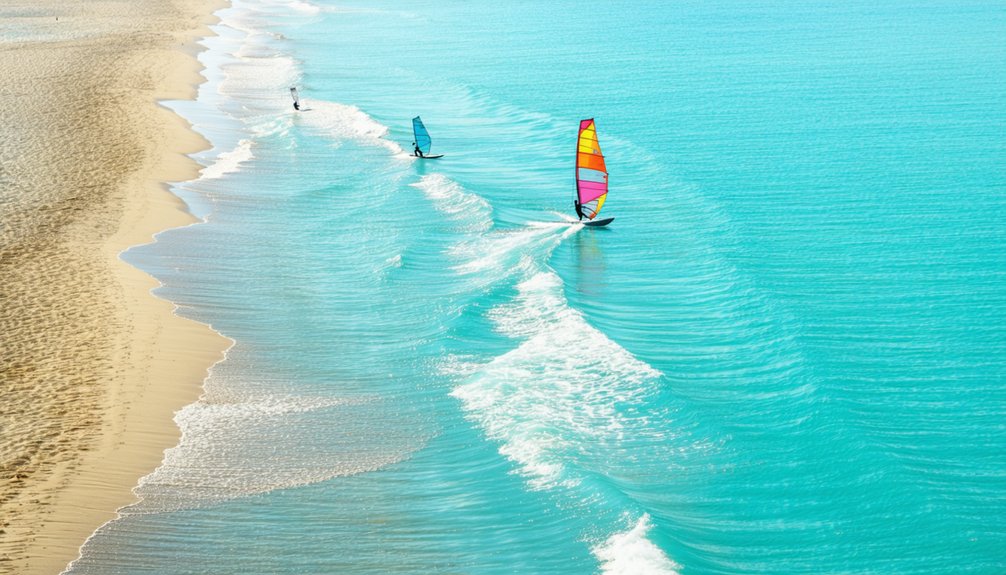
Planning your Sri Lankan beach activities depends heavily on which coastline you’re visiting, as monsoon patterns create distinctly different peak seasons. The southwest coast offers prime diving from November to April with visibility reaching 30 meters, while the east coast delivers epic surf conditions at Arugam Bay from May to September.
You’ll find year-round water sports hubs scattered across the island. Bentota’s calm waters are perfect for jet skiing and parasailing, while Negombo’s lagoon system supports kayaking throughout the seasons. For wildlife enthusiasts, you can combine whale watching in Trincomalee (June-October) with surfing adventures, or time your visit to coincide with turtle nesting season (January-April) along the southwest coast. The clear waters of Pigeon Island provide exceptional diving and snorkeling experiences at its vibrant marine national park.
Don’t let monsoons derail your plans – when one coast is affected, the opposite shore typically offers ideal conditions. Kalpitiya’s kitesurfing scene thrives December through August, and Pigeon Island’s protected reefs guarantee year-round snorkeling opportunities.
Budget-Friendly Travel Periods
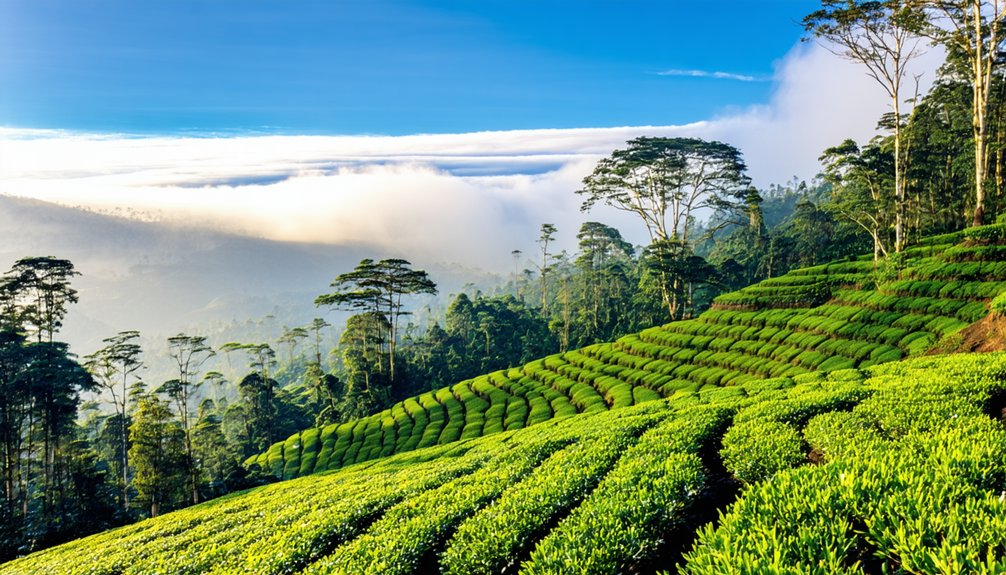
Savvy travelers looking to explore Sri Lanka’s wonders can find significant savings by timing their visits strategically throughout the year. You’ll discover substantial accommodation discounts during the southwest monsoon season (May-August), with rates dropping 30-50% in popular coastal areas. Transportation cost savings are equally impressive, with train fares slashed by half and car rentals reduced to $30/day during this period.
The shoulder seasons (April and September-November) offer balanced value, featuring moderate weather and 15-25% discounts on hotels and tours. The ideal time to visit golden beaches in Bentota and Mirissa is during this period when prices are lower. For maximum budget efficiency, consider these money-saving strategies:
- Target the northeast coast from February-September for budget rooms at $15-30/night
- Avoid major festivals like Vesak Poya when prices surge up to 40%
- Book flights during September-November for promotional fares
- Explore the Cultural Triangle in April/October when crowds thin out
- Utilize competitive tuk-tuk rates during low season for local transport
Month-by-Month Temperature Overview
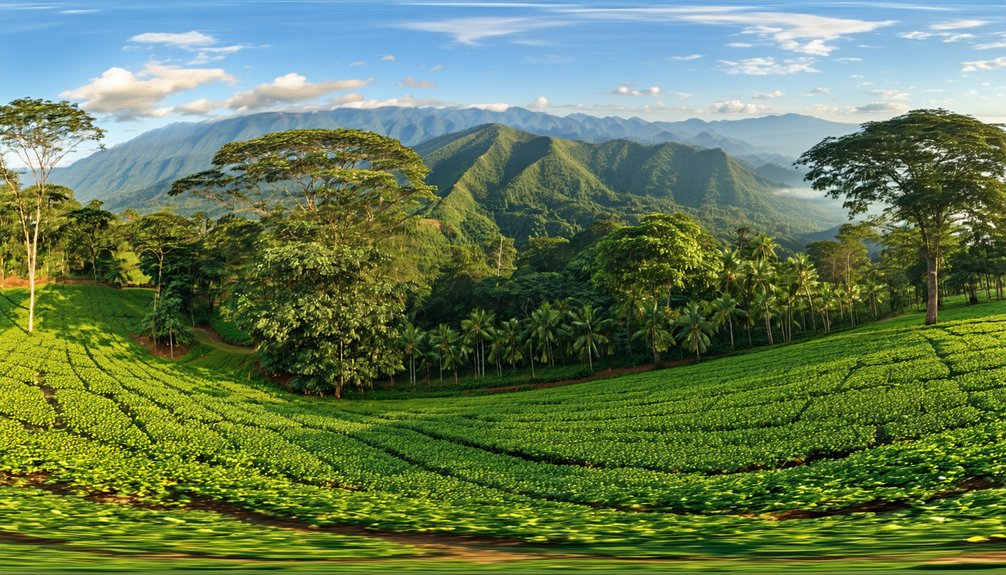
Consistently warm temperatures make Sri Lanka an inviting destination year-round, with distinct patterns you’ll want to examine when planning your visit. The seasonal temperature variations follow a predictable rhythm, particularly during the peak dry season from January through March.
You’ll find January averages hovering around 25°C across the country, with Colombo reaching highs of 31°C. As you move into February, the monthly weather patterns show a slight uptick to 25.7°C nationwide, while Kandy offers a pleasant range between 19-29°C. March introduces the first warming trend, pushing the national average to 26.9°C, though the hill country maintains its invigorating climate between 21-31°C.
Coastal areas like Galle maintain their tropical charm with consistent temperatures between 30-32°C. If you’re seeking the driest conditions, January in Colombo sees minimal rainfall at just 20mm, making it ideal for outdoor exploration. The northern region around Jaffna experiences a much drier climate compared to the southern regions of the country.
Adventure Sports & Trekking Windows
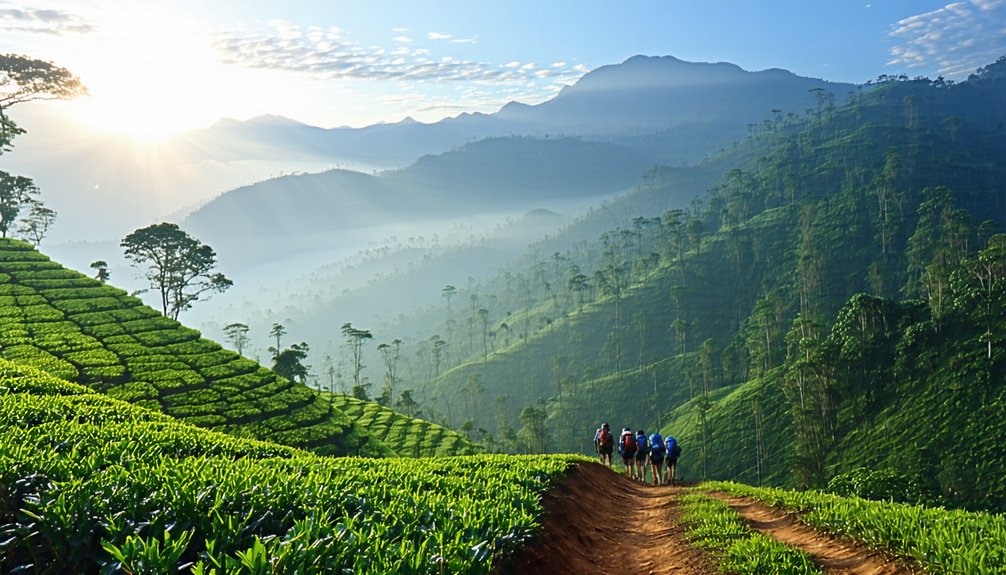
Every adventurer seeking thrills in Sri Lanka will find distinct seasonal windows that maximize both safety and excitement. For budget-friendly adventure trips, you’ll want to align your visit with ideal seasonal conditions. White water rafting enthusiasts should head to Kitulgala between November and April for Grade III rapids, while kayakers can explore Madu River’s mangroves year-round, with peak conditions from December to March. Surf enthusiasts can catch some of the world’s best waves at Arugam Bay during the peak season of May to September.
Plan your Sri Lankan adventures around peak seasonal windows to maximize thrills while keeping costs manageable and safety in check.
For seasonal activity recommendations, consider these prime windows:
- Trek the Hill Country from December to March when temperatures hover between 15-25°C
- Scale Adam’s Peak during December-April for clear sunrise views
- Chase leopards in Yala National Park from February to July
- Witness Minneriya’s elephant gathering in August-September
- Experience rock climbing at Dambulla from November to April
Your adventure costs remain reasonable, with rafting packages starting at $30 and safari experiences ranging from $30-100, depending on your chosen duration and vehicle type.

